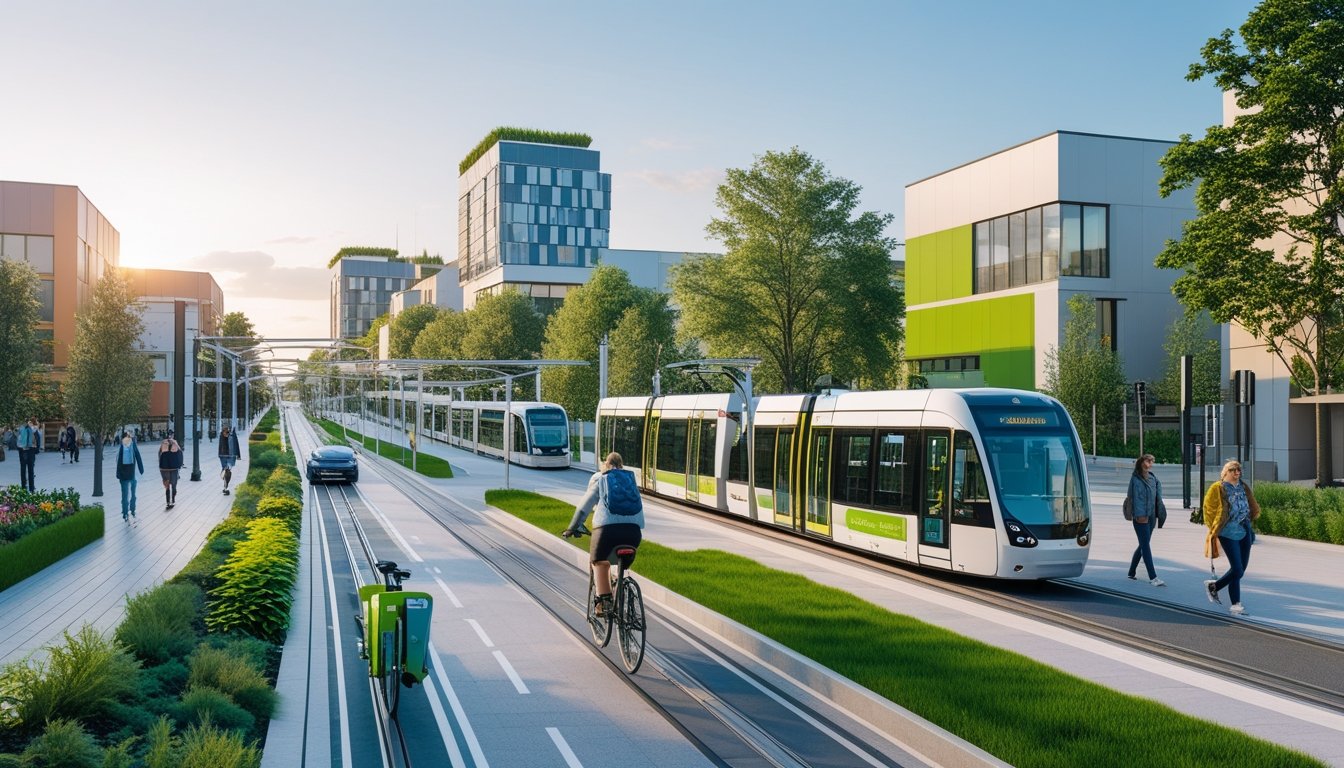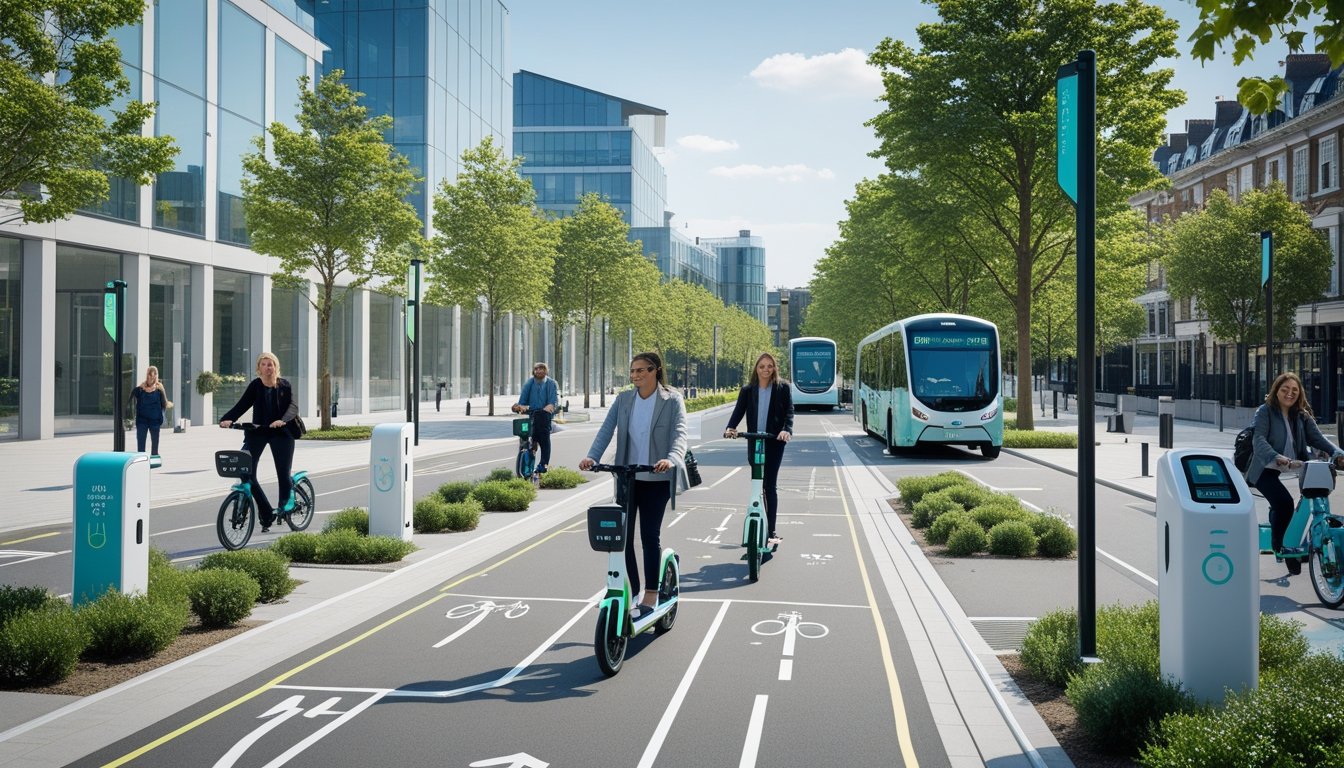Late updated: 14 Nov 2025 08:11
Written by: Eleanor Hartman
Sustainable Urban Transportation Solutions In The UK: Innovations and Challenges
Sustainable urban transportation solutions in the UK have become an essential focus in tackling environmental concerns and improving urban living. Cities across the UK are pioneering innovative solutions to create more eco-friendly, efficient, and accessible transport systems. From electric buses to enhanced cycling infrastructure, these initiatives reduce carbon emissions and improve the quality of life for urban dwellers.

We are witnessing a shift towards sustainable transport modes that include public transport electrification, increased cycling lanes, and the development of pedestrian-friendly areas. These efforts are crucial for meeting the UK's ambitious net-zero emission targets by 2050. With urban areas making significant strides, sustainable transport is not just a vision for the future but a significant part of the present.
As we delve into how these strategies are reshaping urban mobility, we will explore the key methods driving this change. By understanding these efforts, we can better appreciate the role of sustainable transport in shaping a greener and more efficient future.
Key Takeaways
- Sustainable transport reduces emissions and enhances urban living
- UK cities are leading with innovative eco-friendly solutions
- Urban transport electrification is crucial for net-zero goals
Core Sustainable Urban Transport Solutions in the UK

In the UK, sustainable urban transport solutions focus on innovative public transport, enhanced cycling and walking paths, electrification of vehicles, and shared mobility initiatives. These efforts work together to create a greener and more efficient transport network.
Public Transport Innovation
Public transport systems are central to reducing carbon emissions in urban areas. Investment in clean rail technology and alternative propulsion systems has been pivotal.
Our cities are enhancing energy optimisation within transit systems, aiming to lower emissions. Flexible train designs now accommodate more passengers, improving efficiency. In London, for example, the expansion of the Tube alongside upgrades to buses supports eco-friendly transit goals. By prioritising public transport, we can significantly reduce urban pollution and improve air quality.
Cycling and Walking Infrastructure
Incorporating cycling and walking into our cities requires notable infrastructure enhancements. We’re witnessing the expansion of cycle lanes and pedestrian pathways in key urban areas.
Cities like Manchester and Bristol are developing these networks, aiming to encourage active travel. It’s crucial that these facilities are safe and easily accessible to all citizens. As more people opt for cycling or walking over driving, pollution levels decline. Cycling infrastructure also includes secure bike parking and repair stations to support cyclists daily. This active transport not only reduces emissions but promotes healthier urban living.
Electrification and Electric Vehicles
The electrification of personal and public transport is gaining momentum across the UK. Charging stations are integral, with efforts to place them conveniently in cities to support electric vehicle (EV) growth.
Electric buses are also emerging as viable alternatives, gradually replacing diesel models. With incentives for EV purchases, citizens are encouraged to transition toward environmentally friendly vehicles. These actions aid in curbing carbon footprints and contribute vastly to sustainable urban mobility. As we move towards decarbonising transport, the push for EV adoption remains a significant focus to achieve cleaner air in urban regions.
Shared Mobility and Mobility Hubs
Shared mobility services, such as car sharing and bike sharing, are becoming staples in urban transport ecosystems. Mobility hubs act as central points where various transport options are available.
These hubs integrate bus services, bike shares, and even car rentals, promoting seamless transport transitions. Shared mobility reduces traffic congestion by decreasing reliance on private vehicles. We view these hubs as crucial facilitators of smart mobility. Urban planners are ensuring accessibility to these services to enhance commuter convenience. As shared mobility expands, it brings a sustainable alternative to traditional urban transport while retaining flexibility and lowering costs for users.
Key Strategies for Achieving Net Zero and Urban Transport Decarbonisation

Achieving net zero in urban transportation requires adopting innovative techniques and encouraging collaboration among various stakeholders. Each strategy focuses on reducing emissions, enhancing infrastructure, and fostering community involvement.
Alternative Sustainable Fuels and Technologies
Transitioning to alternative fuels is a cornerstone in the push for decarbonisation. Urban spaces benefit significantly from adopting biofuels, hydrogen fuel, and synthetic fuels. Hydrogen-powered vehicles, using hydrogen fuel cells, offer zero emissions and a sustainable power source. These technologies transform the landscape of city transport, aiding in emission reduction.
Sustainable Aviation Fuel (SAF) introduces possibilities for decarbonising aviation, an integral part of national transport networks. Integrating renewable energy sources within urban infrastructures supplements these changes. Establishing a robust regulatory framework ensures that new technologies and fuels are implemented effectively, supporting cities in meeting emissions targets.
Behaviour Change and Stakeholder Involvement
Encouraging behaviour change among citizens is paramount. We must foster community engagement and create co-creation initiatives, where residents actively participate in shaping their urban environments. This requires clear communication strategies, highlighting the benefits of decarbonisation, to facilitate a shift in public attitude.
Engagement must extend to various stakeholders, including government bodies and private enterprises, to ensure that policies reflect the population’s needs. Building on the Glasgow example, successful community engagement enhances the policies aimed at achieving net zero. By fostering an inclusive dialogue, we can secure widespread support for sustainable transport initiatives.
Green Infrastructure and Air Quality Improvement
Investing in green infrastructure supports urban resilience, particularly against extreme weather events exacerbated by climate change. Planting trees and creating green corridors near urban roads can significantly improve air quality, benefiting public health and enhancing the quality of life.
Impact assessments are crucial in understanding how these initiatives affect local ecosystems and public wellbeing. A proactive approach to green infrastructure implementation, informed by environmental assessments, can enhance urban landscapes and reduce exposure to harmful pollutants. This, in turn, leads to better health outcomes and contributes to meeting decarbonisation goals.
Frequently Asked Questions

Our exploration of sustainable urban transportation solutions in the UK covers various initiatives, government plans, and technological advancements. We focus on supporting cycling, public transport development, reducing congestion, and promoting cleaner vehicle usage.
What initiatives are in place to promote cycling in urban areas of the UK?
Local governments have invested in extensive cycling infrastructure. There are dedicated bike lanes, bicycle-sharing schemes, and educational campaigns to encourage cycling as a sustainable transportation mode.
How does the UK government plan to increase the use of public transport in cities?
The government aims to enhance public transport by funding improvements in bus and rail networks. This includes increasing service frequency and upgrading stations to make them more accessible and efficient.
What measures are being taken to reduce traffic congestion in major UK cities?
Congestion is being tackled through the implementation of congestion charges, encouraging the use of public transport, and promoting active travel options like walking and cycling.
Can you describe the impact of low-emission zones on urban transportation in the UK?
Low-emission zones help decrease pollution by restricting high-polluting vehicles. These initiatives are meant to improve air quality and encourage the shift to cleaner modes of transport.
In what ways are emerging technologies being integrated into the UK's urban public transport systems?
The integration includes real-time tracking apps, contactless payment systems, and the adoption of electric and hydrogen-powered buses to reduce emissions and improve user experience.
What incentives are available for UK residents to switch to electric vehicles?
Incentives include grants for purchasing electric vehicles, reduced taxes, and support for installing home charging points. These measures aim to make the transition to cleaner vehicles more appealing and cost-effective.